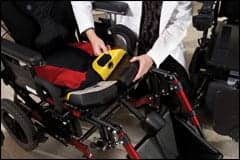Ipsen announces findings from a new US healthcare database analysis to assess the current treatment patterns of adults living with spasticity in a real-life setting.
The analysis focused on the proportion of people living with active spasticity who received botulinum neurotoxin type A (BoNT-A) treatment. The abstract, Analysis of US Commercial Claims to Understand Patient Treatment Pathways in Spasticity, was presented recently during the International Society of Physical and Rehabilitation Medicine (ISPRM) 2021 Congress.
Spasticity is usually caused by damage to the parts of the brain or spinal cord that control voluntary movement, leading to a change in the balance of signals between the nervous system and the muscles, which results in increased activity in the muscles. When injected into specific muscles of people living with movement disorders, BoNT injections cause temporary muscle relaxation, which can ease symptoms and aid rehabilitation. BoNT-A injections are considered as a recommended first-line treatment for adults living with spasticity in several countries, including the US, a media release from Ipsen explains.
Claims Analysis
Ipsen analyzed data from two large US commercial claims databases: IBM Watson’s MarketScan and the IQVIA Anonymous Longitudinal Patient Data (APLD) database:
- A total of 4,974,859 records were accessed in the MarketScan database, and 10,685,964 records in the IQVIA database.
- Spasticity was identified from the two sources using International Classification of Disease (ICD) codes for spastic conditions (eg, monoplegia, diplegia, hemiplegia and contracture).
- This revealed 126,465 and 1,151,127 people living with spasticity in the MarketScan and IQVIA databases, respectively.
- In the MarketScan database, only 5,111 people living with spasticity (4%) were treated with BoNT-A. In the IQVIA database, an even smaller percentage were treated with BoNT-A (31,176 patients, 3%).
“While effective treatment of spasticity requires a multidisciplinary approach, which may involve a combination of exercise, physical therapy, medication, or surgery, it is concerning to see that many people living with spasticity in the US are not receiving a recommended first-line treatment. The pandemic has been disruptive to the management of spasticity; these new data have, however, put a spotlight on the broader issues in the treatment of this condition that pre-date the pandemic.”
— Isabelle Bocher-Pianka, Chief Patient Affairs Officer at Ipsen
“We need to address barriers to treatment and find innovative ways to address the access issues in the treatment of this debilitating condition. Despite being a recommended first-line treatment, these data highlight a significant disconnect between the patient journey and the guidelines, since BoNT-A is only used for a small proportion of people living with spasticity in the US and this is likely to be true in other parts of the world.”
— Dr Alberto Esquenazi, Sheerr Gait and Motion Analysis Laboratory, MossRehab
“Poor control of spasticity can result in the breakthrough of painful symptoms such as muscle stiffness, spasms and involuntary contractions, which means the person living with spasticity may find it difficult to walk or perform certain tasks. These data show there is an urgent need to build on these findings and gather further insights into the underlying reasons for this disconnect.”
— Dr. Andreas Lysandropoulos, Vice President, Head of Global Medical Affairs Neuroscience at Ipsen
[Source(s): Ipsen, Business Wire]
Related Content:
DaxibotulinumtoxinA Injection for Upper-Limb Spasticity Study Receives Positive Results
Treat SCI Spasticity with Neuromodulation, FEFU Scientists Suggest
Dysport OK’d to Treat Both Upper- and Lower-Limb Spasticity in Children





